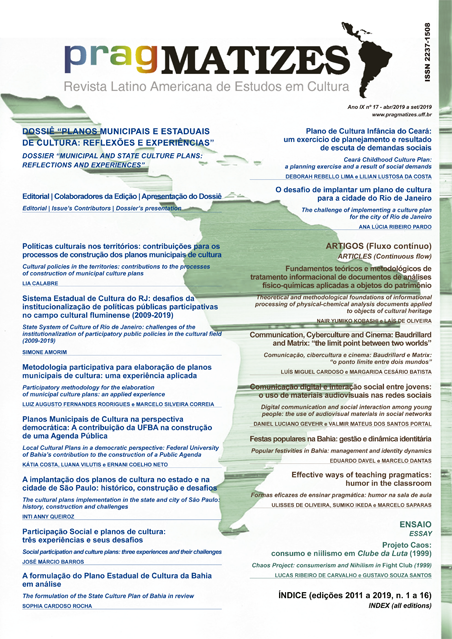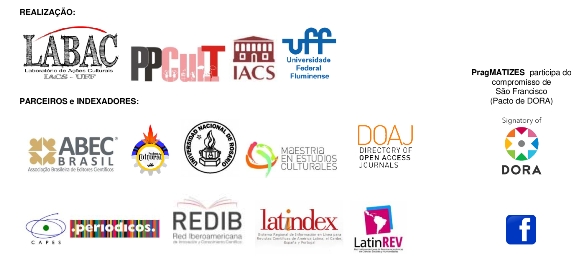Communication, Cyberculture and Cinema: Baudrillard and Matrix: "the limit point between two worlds"
DOI:
https://doi.org/10.22409/pragmatizes.v9i17.28016Keywords:
Communication, Cyberculture, Cinema, Baudrillard, MatrixAbstract
Nowadays, we live in the so-called Network Society (Castells, 2003), a reality in which presence is no longer limited to physical places and begins to happen especially in virtual places. The online environment has come to emerge what is known as Cyberculture, a characteristic phenomenon of cyberspace and in which the pre-existing culture extends and renews itself and recreates itself. In this paper, we seek to explore the question of identity and the doubts that hang in the head of the human being about what is considered real or not, making use of the film The Matrix (1999), of the Wachowski brothers, where we will retrieve excerpts from the film and with which it can be connected with Simulacra and Simulation (1981).
Downloads
References
BAUDRILLARD, J. Simulacra and Simulation - Translated by Sheila Faria Glaser. Michigan: The University Of Michigan Press, 1994. Available at https://books.google.com.br/books?hl=pt-PT&lr=&id=9Z9biHaoLZIC&oi=fnd&pg=PA1&dq=baudrillard+simulacra+and+simulation&ots=3NS4i2gAnV&sig=vGIaqO6nqwzK_TB_TixfNL1QDrE#v=onepage&q=baudrillard%20simulacra%20and%20simulation&f=false. Access in 01 july 2018.
CORREIA, M. A fluidez das identidades na contemporaneidade e as redes sociais. Revista Communitas, Vol. 1, Nº 1, Acre, 2017. Available at http://periodicos.ufac.br/revista/index.php/COMMUNITAS/article/view/1105/pdf. Access in 25 june 2018.
DEVI, G. The Concept Of Hyperrealism in Cyberpunk Films. The Film The Matrix (1999): a Case Study. The 11th International Conference of ISSEI. Language Centre, University of Helsinki. Finland, 2008. Available at https://helda.helsinki.fi/bitstream/handle/10138/15197/67_Gayadri%20Devi.pdf?sequence=1. Access in 02 july 2018.
ESPANHA, R.; POUPINHA, L. Matrix: teoria geral e três casos práticos. Livro de Actas – 4º SOPCOM, 2005. Available at https://www.researchgate.net/publication/242755554_Matrix_Teoria_Geral_e_Tres_Casos_Praticos. Access in 03 july 2018.
LÉVY, P. Cibercultura [Tradução de Carlos Irineu da Costa]. São Paulo: Editora 34, 1999. Disponível em https://books.google.pt/books?hl=pt-PT&lr=&id=7L29Np0d2YcC&oi=fnd&pg=PA11&dq=cibercultura+autores&ots=gjSuvB_Ccj&sig=mIY3YQbOUNW_XLL4LpnS-j2hf5Q&redir_esc=y#v=onepage&q=cibercultura%20autores&f=false. Acesso em 03 julho 2018.
MASSAGLI, S. Identidades culturais no deserto do hiper-real no filme Matrix. Estudos Linguísticos, 37 (3), p. 371-378, set-dez. 2008. Disponível em https://www.researchgate.net/publication/228453064_Identidades_culturais_no_deserto_do_hiperreal_no_filme_Matrix. Acesso em 03 julho 2018.
MERRIN, W. Did You Ever Eat Tasty Wheat?: Baudrillard and The Matrix. Swansea, U.K.: University of Wales, 2003. Available at https://www.nottingham.ac.uk/scope/documents/2003/may-2003/merrin.pdf. Access in 02 july 2018.
MOREIRA, A. Matrix Iluminismo e afins. Livro de Actas – 4º SOPCOM, 2005. Disponível em http://revistas.ua.pt/index.php/sopcom/article/view/3157. Acesso em 02 julho 2018.
PIRES, H. Do gesto hesitante da dor à fusão apocalíptica do corpo. Leitura de crítica das ligações na era da técnica, org. de Bragança de Miranda e Teresa Cruz. Revista Comunicação e Sociedade. Vol. 4, 2002. Disponível em http://revistacomsoc.pt/index.php/comsoc/article/view/1305/1239. Acesso em 01 julho 2018.
PRAZERES, R. Cidade e Ciberespaço em Seis Dicotomias: espaço e tempo; corpo e conexão; alienação e fragmentação. Dissertação de Mestrado em Arquitetura – área de cultura arquitetónica. Guimarães: Universidade do Minho, 2014. Disponível em https://repositorium.sdum.uminho.pt/bitstream/1822/30605/1/Disserta%C3%A7%C3%A3o_Rui%20David%20Couto%20Prazeres_2014.pdf. Acesso em 29 julho 2018.
RIBEIRO, F. Opinião Pública nos Média em Portugal: quem participa e porquê?. Braga: Universidade do Minho, CECS - Centro de Estudos de Comunicação e Sociedade, 2017. Disponível em https://repositorium.sdum.uminho.pt/bitstream/1822/46238/1/2017_Ribeiro_livro-opiniao-publica.pdf. Acesso em 03 julho 2018.
SANTAELLA, L. Da Cultura das Mídias à Cibercultura: o advento do pós-humano. Revista Famecos, nº 22, Porto Alegre, 2003. Disponível em https://www.passeidireto.com/arquivo/4731900/da-cultura-das-midias-a-cibercultura_lucia-santaella. Aceso m 27 junho 2018.
SANTOS, A. A Construção de identidades e de subjetividades no ciberespaço. Revista Logos, Vol. 8, nº 1, Rio de Janeiro, 2001 Disponível em http://www.e-publicacoes.uerj.br/index.php/logos/article/view/14765. Acesso em 25 junho 2018.
STANFORD ENCYCLOPEDIA OF PHILOSOPHY. Jean Baudrillard. 2007. Available at https://plato.stanford.edu/entries/baudrillard/#2. Access in 01 july 2018.
THE GUARDIAN [International edition]. Jean Baudrillard. 2007. Available at https://www.theguardian.com/news/2007/mar/07/guardianobituaries.france. Access in 01 july 2018.
THITY-CHERQUES, H. (2010). Baudrillard: trabalho e hiper-realidade. RAE-eletrônica, vol. 9, nº 1, Art. 7, Escola de Administração de Empresas de São Paulo. Fundação Getulio Vargas, São Paulo, 2010. Disponível em http://www.scielo.br/scielo.php?script=sci_arttext&pid=S1676-56482010000100008. Acesso em 01 julho 2018.
UOL EDUCAÇÃO. Jean Baudrillard. S/d. Access 01 july 2018 athttps://educacao.uol.com.br/biografias/jean-baudrillard.htm
Published
How to Cite
Issue
Section
License
By forwarding an original to PragMATIZES, the authors agree that the copyright related to it is transferred to the Publishing. Articles and other writings are made available in PDF format from their publication, and they can be downloaded to institutional repositories and personal pages, provided that with their proper bibliographic indication.



